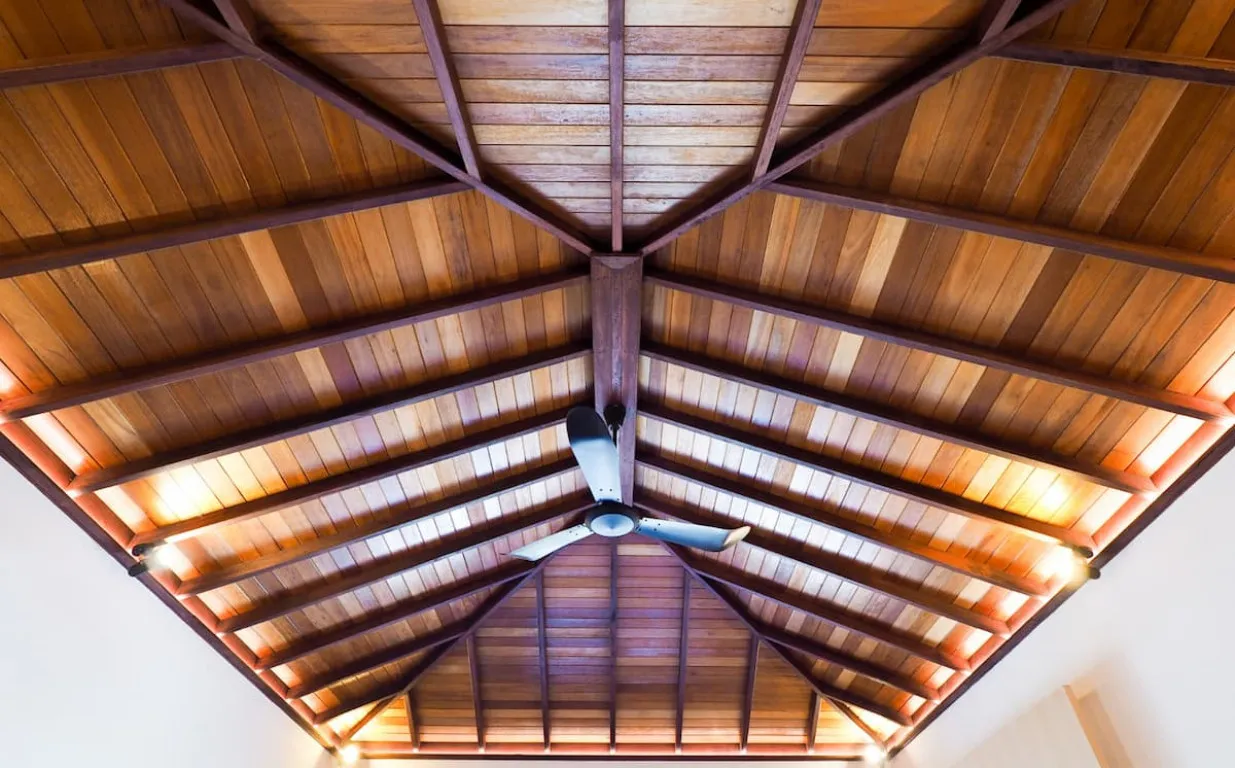The ceiling is an important element in a building structure because it not only covers the roof truss but also aesthetically enhances the house interior.
In modern architecture, the ceiling has become a crucial element due to its role in making the room attractive, fixing acoustics, and adding thermal comfort.
Furthermore, the ceiling hides electrical installations, pipes, and ventilation systems that can interfere with the room's appearance if left exposed. Choosing the right type of ceiling can increase comfort, energy efficiency, and the aesthetic value of your home.
In this article, you will learn more about the various types of ceilings commonly used in Indonesia, their advantages and disadvantages, and considerations in choosing the type of ceiling.
What Is a Ceiling?
In general, a ceiling is a surface covering the upper part of a room's interior. Its main function is to separate the room and the roof. In the in-house context, a ceiling works to create a homey ambiance, give certain visual effects, and maintain the air circulation and temperature in the room.
The ceiling can also be a decorative element that gives identity or character to a room. Therefore, the design and material of the ceiling must be carefully considered based on the room's function and your taste in style.
Read also: Learn About Cement Raw Materials, Types, & How to Make It
Types of Ceilings
Here is the complete explanation about some types of ceiling you must know:
1. Gypsum Ceilings
The gypsum ceiling is one of the most popular ceilings in the urban community. This material is made of gypsum molded into a board and installed using a hollow truss.
Due to its smooth and malleable appearance, this ceiling is often used for minimalist to classic modern room designs. Moreover, gypsum ceilings are also ideal for home interiors that require high aesthetics at a relatively affordable cost.
Advantages:
- Fast and easy installation.
- Smooth and aesthetic surface.
- Malleable into tier ceilings.
Disadvantages:
- Not waterproof and prone to high humidity.
- Prone to impact.
2. Polyvinyl Chloride (PVC) Ceiling
PVC ceilings are made of high-quality plastics resistant to water, humidity, and pests like termites. The main advantage is durability and easy maintenance.
Unlike conventional ceilings, PVC ceilings come in many attractive colors and textures. This allows you to customize it to suit your home's interior design concept.
Advantages:
- Waterproof and termite-proof.
- No need for paint.
- Vary in motives and colors.
Disadvantages:
- Less natural for traditional houses.
- Less environmentally friendly because it is made of plastic.
3. Wooden Ceilings
This type of ceiling gives a warm, natural, and luxurious appearance to your rooms. The wood types commonly used for ceilings include teak, merbau wood, and bangkirai wood.
The uniqueness of the wood's natural fibers makes this ceiling suitable for ethnic, tropical, or classic-style homes. However, it requires extra care to prevent it from rotting quickly or attracting termites.
Advantages:
- High aesthetic and gives natural nuances.
- Strong and long-lasting if well-maintained.
Disadvantages:
- Prone to termites.
- Relatively expensive.
4. Plywood Ceilings
Plywood ceilings are an economical option. These ceilings, made from thin sheets of pressed wood, are often found in simple houses or semi-permanent buildings. Although it is not as strong or captivating as gypsum or wood ceilings, plywood ceilings are still a practical choice in certain conditions.
Advantages:
- Cost-effective.
- Installable.
Disadvantages:
- Prone to water and bend.
- Less durable.
5. Metal Ceilings
Metal ceilings are usually made of aluminum or light-gauge steel. They are used in buildings with industrial or commercial designs. In addition to its high durability, this type of ceiling is also fireproof, making it suitable for public buildings. The disadvantages are that the acoustic and aesthetic aspects are not suitable for all types of houses.
Advantages:
- Durable and termite-proof.
- Waterproof and fireproof.
Disadvantages:
- May cause noise when raining.
- Installation requires specialized skills.
Read also: Gypsum, a Multifunctional Building Material
Factors to Consider in Choosing Ceilings
Choosing the right ceilings for houses and rooms is not only about functionality but also long-term convenience and aesthetics. Several factors need to be considered to make your choice fit your needs and budget. Here are the factors that you should consider:
1. Environment and Climate
If you live in an area with high humidity or frequent exposure to rain, choosing a ceiling material resistant to moisture is essential. Gypsum or plywood ceilings can be easily damaged by humidity. Thus, you can opt for materials like PVC or metal that are more resistant to humid conditions and less prone to rotting.
2. Budget
Budget is also important. Plywood or gypsum ceilings are generally more affordable than wood or metal ceilings. However, if you consider the long term, investing in more durable materials, such as metal or wood, can reduce future maintenance costs. Therefore, you must choose a material that fits your budget while still providing optimal results.
3. Interior Aesthetic
The types of ceiling also play an important role in creating the desired interior atmosphere. Wooden ceilings provide a natural and warm feel that is suitable for classic or rustic styles.
On the other hand, PVC and metal ceilings offer a modern and minimalist impression, perfect for contemporary interior design. You can customize the ceiling material with the home design to create an overall visual harmony.
4. Easy Maintenance
PVC ceilings are known for their resistance to moisture, dust, and dirt, and do not require intense maintenance. It is easier to clean and does not require repainting, making it more efficient in terms of time and cost.
In contrast, wooden or gypsum ceilings may require repainting and more regular maintenance, especially if they are exposed to moisture or direct sunlight.
5. Isolation and Soundproofing
Aside from aesthetics and maintenance, you also need to consider the ceiling's soundproofing and insulation capabilities. Certain materials, like gypsum, can help muffle sound, providing more comfort in spaces that require quietness, such as bedrooms or workspaces.
The ceiling is not only a structural element but also a part of interior design that creates visual and functional comfort. By understanding the various types of ceilings and their advantages, you can choose the right ceiling for your home, both in terms of aesthetics, functionality, and cost.
Additionally, it is also important to consider the sustainability of the ceiling materials used, especially in the context of being environmentally friendly. Choosing materials that can be recycled or have a low carbon footprint will make a positive contribution to the environment in the long run.
If you are interested in using an eco-friendly cement with the best quality, Semen Merah Putih Flexiplus, Durapro, and Ecopro are the right choices. Those three are eco-friendly with lower carbon dioxide emissions, making them suitable for projects prioritizing energy efficiency and sustainability.
Are you curious about those three cement products? Contact us now to get more information about Semen Merah Putih products. We are ready to help you find the best solution for your eco-friendly and sustainable development needs!
Read also: What Is Green Cement? The Benefits and Types You Must Know!



